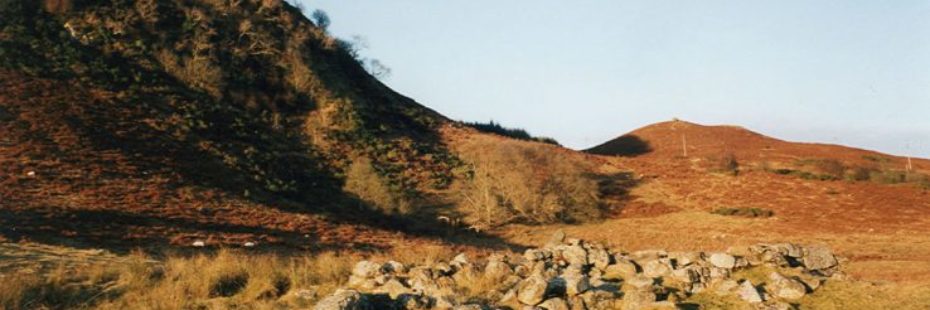
Callander
Callander is a bustling tourist town situated on the River Teith and A84, west of Stirling, and gives visitors travelling north their first taste of the Highlands. It is set dramatically beneath high, wooded crags, and gained fame as the location for the original Doctor Findlay’s Casebook television series.

Bracklinn Falls
Setting
Being a busy town, there’s plenty of shops to delve into and tasty options for morning coffee, lunch, afternoon tea or an evening meal. Cycle hire is available if you fancy exploring the area by pedal power with good quality cycle paths nearby.
Callander’s Pass, formed during the last ice age, is a prominent and distinctive landscape feature that has dominated Callander’s history. The Pass is a gateway between lowland and highland Scotland and through the ages has provided a physical backdrop to arguably some of Scotland’s most colourful stories in history.

Stone ruin, Callander
History & heritage
Callander and its surrounding area are steeped in history, interesting geological features – clan burial grounds, Iron Age hill forts, glacial erratics, Neolithic burial cairns and more, and all can be discovered on foot or bike.
The Roman Army was based in Callander, strategically positioned beneath Callander’s Pass – a glen blocker to defend the Roman Empire. The Roman and prehistoric sites at Callander are scheduled as being of national importance. The fort is unique in the Park as still having upstanding visible remains, which makes it important for both locals and visitors, including international interest.
Callander still retains its original street plan dated to 1739 and much of its historical character, being designated as a Conservation Area. The town is characterised by tightly packed, gable to gable rows of houses and hotels set hard onto the heel of the pavement on each side of the street, generally one to two storeys high – this is echoed in streets behind.
In Victorian Times Callander boomed as a tourist destination off the back of the Romantic Movement, with poets and writers promoting the landscape surrounding Callander. Today, Callander has a pro-active community with a wide range of groups, societies and businesses who are working together to offer more to those who visit and live in the town.
To find out about the fascinating geology of its area, read the ‘Stories in the Landscape Geodiversity Trail’ leaflet.

Streetscape
Walking in Callander
There are a number of popular walks in the area for visitors to explore. The beautiful Bracklinn Falls and the River Keltie have mesmerised people for generations, to the west footpaths and cycle tracks follow the old Callander to Oban railway, and from the summit of the Callander Crags there are spectacular sweeping views over the town of Callander and beyond, to Stirling and the Forth Estuary.
- The Three Bridges – 4.5 miles (7.2 km), a moderate route taking in the Roman fort, Samson’s Stone, Dunmore Fort and Coilhallan Wood
- Callander Crags – 2.3 miles (3.7 km), a steep climb to be rewarded with great views over Callander, Loch Venachar, Ben Ledi and beyond
- The Lower Woods – 1.9 miles (3 km), a moderate route through the town centre and nearby woods
- Callander Meadows – 1.1 miles (1.8 km), an easy surfaced route along the River Teith
- Bracklinn Falls Circuit – 3.5 miles (5.3 km), well compacted path with some loose materials
- The Glacier Trail – 2.2 – 2.9 miles (3.5 – 4.7 km), an easy route exploring the town’s glacial deposits left at the end of the last Ice Age
Find out more about the Callander routes.
Did you know?
Europe’s largest burial cairn lies largely unknown on the edge of the town, surrounded by countless smaller versions which we believe may hold the secrets of prehistory’s first religious rituals.
Find out more…
- Learn about Callander’s Landscape, an exciting project that focuses on the dramatic landscapes that surround Callander, improving natural and cultural heritage and ensuring that more people can access this awe-inspiring place.
- Find out more about the local community and the work they do.
- Access the Community Action Plan to find information on what it is like to live in Callander and the surrounding area, the aspirations and priorities for the future of the local community and how they will be achieved.
- Visit our camping pages on Loch Venachar, Loch Lubnaig and the surrounding area.
- Download a copy of our SNH Landscape Assessment to learn more about the landscape of the village.

